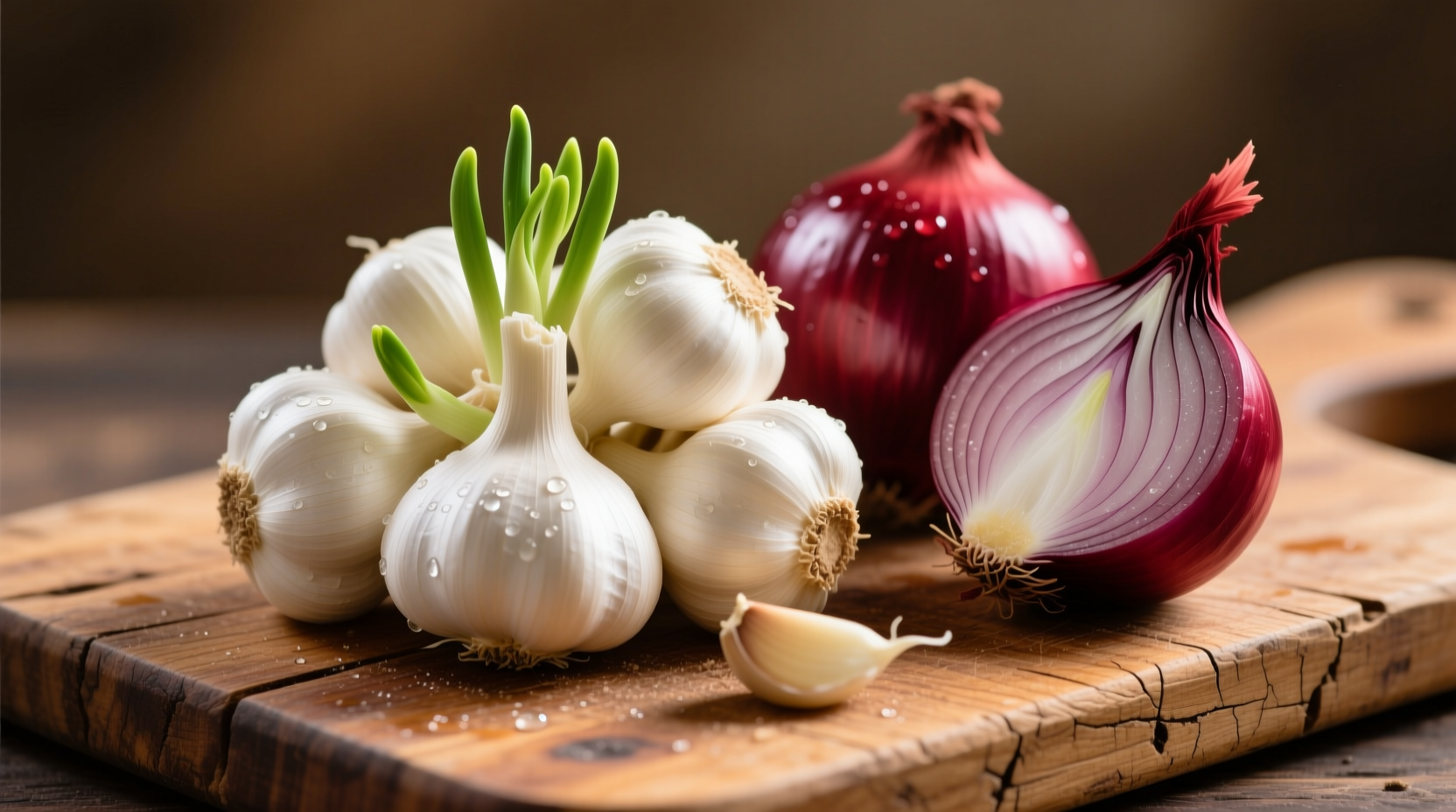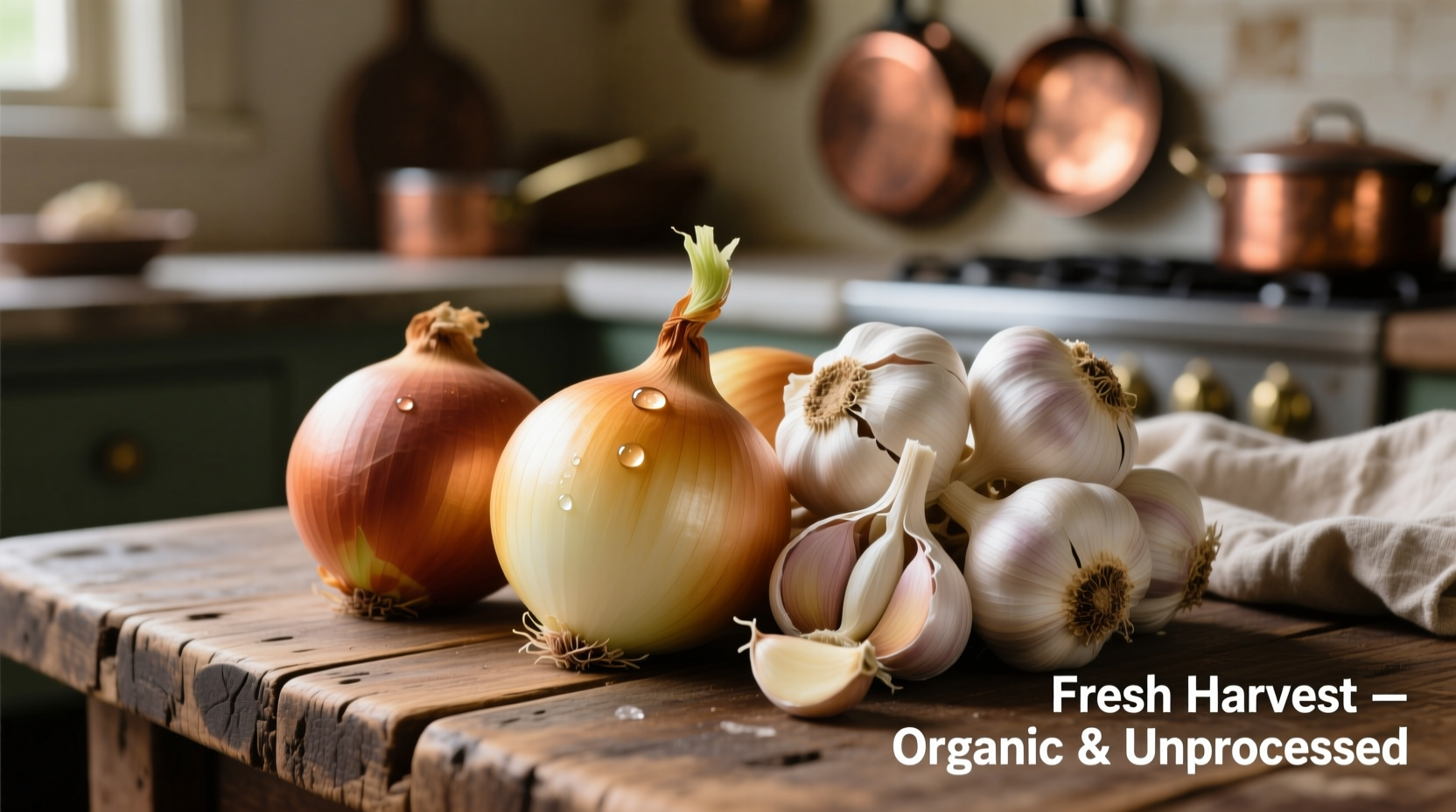Unlocking the Power of These Culinary Essentials
Onions and garlic form the aromatic backbone of countless dishes worldwide, yet many home cooks underutilize their full potential. This comprehensive guide reveals how to maximize flavor, preserve nutritional value, and avoid common preparation mistakes with these indispensable ingredients. Whether you're a beginner cook or seasoned chef, understanding the science and technique behind onions and garlic transforms ordinary meals into extraordinary culinary experiences.
What Makes Onions and Garlic Nutritionally Unique
Both members of the Allium family, onions and garlic contain organosulfur compounds responsible for their distinctive flavors and significant health properties. When damaged through cutting or crushing, enzymes activate to create beneficial compounds like allicin in garlic and various thiosulfinates in onions.
| Nutrient | Raw Garlic (1 clove) | Raw Onion (100g) |
|---|---|---|
| Calories | 4.5 kcal | 40 kcal |
| Vitamin C | 1.0 mg (1% DV) | 7.4 mg (8% DV) |
| Vitamin B6 | 0.03 mg (2% DV) | 0.12 mg (7% DV) |
| Manganese | 0.03 mg (1% DV) | 0.13 mg (6% DV) |
| Key Bioactive Compounds | Allicin, Ajoene | Quercetin, Allyl Propyl Disulfide |
According to research published in the Journal of Nutrition, regular consumption of Allium vegetables correlates with reduced risk of certain cancers and cardiovascular diseases. The National Center for Complementary and Integrative Health confirms garlic's potential to modestly reduce blood pressure in hypertensive individuals when consumed regularly.
Flavor Science: When to Use Each Ingredient
Understanding the flavor evolution of onions and garlic during cooking separates amateur from professional results. Onions contain more natural sugars, making them ideal for caramelization, while garlic's volatile compounds can turn bitter when overheated.
Onion Flavor Development Timeline
- 0-5 minutes (raw): Sharp, pungent bite with enzymatic heat
- 5-10 minutes (sautéed): Sweetness begins to emerge as sugars caramelize
- 15-20 minutes (caramelized): Deep golden brown with complex sweet-savory notes
Garlic Transformation Stages
- Raw: Intense heat and sharpness from allicin
- 30-60 seconds (sautéed): Optimal flavor release without bitterness
- 2+ minutes (overcooked): Bitter, acrid compounds develop

Practical Cooking Techniques You Need to Know
Professional chefs follow specific protocols to maximize flavor while minimizing common mistakes:
Onion Preparation Methods
- Dicing technique: Cut pole-to-pole to minimize tear-inducing compounds
- Caramelization secret: Add pinch of baking soda to accelerate browning (0.1% of onion weight)
- Raw onion mellowing: Soak sliced onions in ice water for 10 minutes to reduce sharpness
Garlic Handling Best Practices
- Crushing vs. mincing: Crush for immediate use in dressings; mince for cooked dishes
- Timing matters: Add to hot oil after onions have softened to prevent burning
- Roasting whole bulbs: Creates sweet, spreadable paste ideal for sauces and breads
Food science research from the University of California confirms that letting crushed garlic sit for 10 minutes before cooking maximizes allicin formation, enhancing both flavor and health benefits. This simple technique, documented by the USDA Agricultural Research Service, significantly increases the bioactive compounds available in your final dish.
Storage Solutions That Maintain Freshness
Proper storage dramatically extends shelf life while preserving flavor compounds:
Onion Storage Guidelines
- Whole bulbs: Store in cool, dark, well-ventilated area (55-60°F)
- Cut onions: Seal in airtight container in refrigerator for 7-10 days
- Avoid plastic bags: Use mesh bags or baskets to prevent moisture buildup
Garlic Preservation Methods
- Whole bulbs: Keep at room temperature with good air circulation
- Peeled cloves: Submerge in olive oil and refrigerate for up to 10 days
- Freezing: Freeze whole unpeeled bulbs or minced garlic in ice cube trays
The FDA Food Code recommends storing garlic in oil below 40°F to prevent botulism risk, while the National Onion Association confirms that refrigeration extends sweet onion shelf life by 2-3 weeks compared to room temperature storage.
Common Misconceptions Debunked
Several persistent myths about onions and garlic affect how people use them:
- "Garlic loses all benefits when cooked" - While raw garlic contains more allicin, cooked garlic still provides significant health-promoting compounds like diallyl disulfide
- "All onions taste the same" - Different varieties serve specific culinary purposes: yellow for cooking, red for salads, sweet for raw applications
- "More garlic is always better" - Excessive garlic can overwhelm dishes; professional chefs typically use 1-2 cloves per serving as standard practice
When to Substitute and What Works Best
Situations arise when onions or garlic aren't available. Understanding appropriate substitutions prevents recipe failure:
Onion Substitutes
- Leeks: Use white and light green parts for milder flavor (use 1.5x volume)
- Shallots: Excellent raw substitute with more delicate flavor (use 1:1 ratio)
- Asafoetida (hing): Pinch for onion flavor in Indian cuisine (especially for onion/garlic-free diets)
Garlic Alternatives
- Garlic powder: Use 1/8 teaspoon powder per clove of fresh garlic
- Chives: For mild garlic flavor in finishing dishes (use 1 tablespoon chopped per clove)
- Roasted garlic paste: Substitute 1 teaspoon paste per clove for milder flavor
Chef's Note: When substituting, consider both flavor profile and texture requirements of your dish. The Culinary Institute of America's research shows that improper substitutions alter the chemical balance of dishes, affecting both taste and texture outcomes.
Maximizing Health Benefits Through Proper Preparation
To optimize the health-promoting compounds in onions and garlic:
- Let garlic rest: After crushing, wait 10 minutes before cooking to maximize allicin formation
- Use minimal water: Steam or roast instead of boiling to preserve water-soluble compounds
- Combine with healthy fats: The fat-soluble compounds in garlic absorb better with olive oil or avocado
- Eat some raw: Include small amounts of raw garlic and onions in salads for maximum enzyme activity
According to a comprehensive review in the American Journal of Clinical Nutrition, consuming garlic and onions as part of a varied diet contributes to cardiovascular health through multiple mechanisms including improved endothelial function and reduced oxidative stress. The World Health Organization recognizes garlic preparations containing at least 1% allicin potential as beneficial for maintaining healthy cholesterol levels.











 浙公网安备
33010002000092号
浙公网安备
33010002000092号 浙B2-20120091-4
浙B2-20120091-4